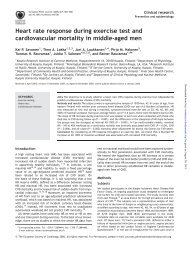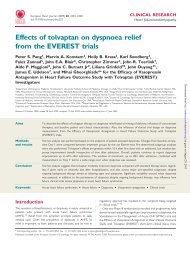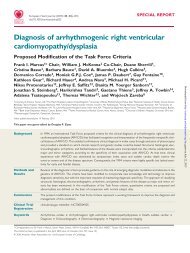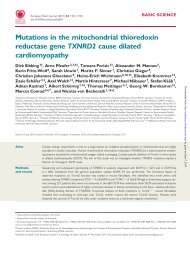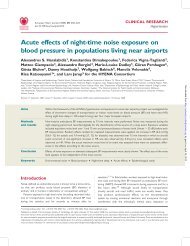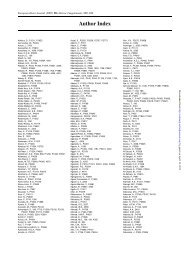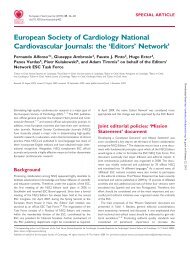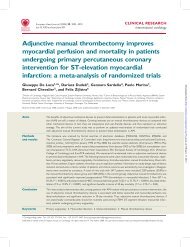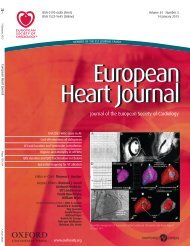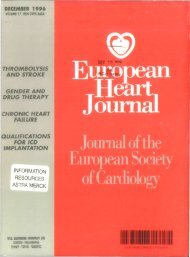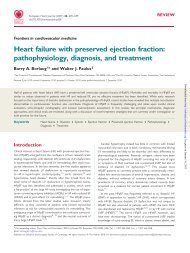Monday, 1 September 2008 - European Heart Journal
Monday, 1 September 2008 - European Heart Journal
Monday, 1 September 2008 - European Heart Journal
You also want an ePaper? Increase the reach of your titles
YUMPU automatically turns print PDFs into web optimized ePapers that Google loves.
292 Atrial fibrillation<br />
Results: LA ejection fraction and fractional shortening were significantly decreased<br />
in PAF. However, LA dimension, A-wave of transmitral flow, and LA emptying<br />
volume were comparable between two groups. The parameters of atrial<br />
dyssynchrony were summarized in Table.<br />
Table 1. Atrial dyssynchrony<br />
Control<br />
Reservoir period<br />
PAF p-value<br />
Ts-SD 16.0±11.4 19.2±15.0 0.258<br />
Tst-SD 29.7±11.9 39.7±15.8 0.001<br />
Tsr-SD<br />
Atrial contraction period<br />
37.3±18.7 41.8±14.1 0.262<br />
Ts-SD 25.9±16.3 33.6±18.6 0.035<br />
Tsr-SD 29.5±14.1 36.9±17.1 0.084<br />
Conclusions: In patients with recent onset PAF, atrial dyssynchrony was present.<br />
Of all parameters, dyssynchronous atrial lengthening assessed by strain during<br />
reservoir period showed the greatest difference between two groups.<br />
P1921 Predictors of mortality in atrial fibrillation<br />
T. Potpara1 ,M.Grujic2 ,J.Marinkovic2 , B. Vujisic2 ,N.Mujovic2 ,<br />
M. Polovina2 . 1Institute for Cardiovascular Diseases, cardiology,<br />
Belgrade, Serbia; 2Institute for Cardiovascular Diseases,KCS,<br />
Belgrade, Serbia<br />
The aim of the study was to assess mortality of patients treated for atrial fibrillation<br />
(AF).<br />
Out of 1100 pts with recently diagnosed AF, aged 52.7±12.0 years, 389 pts<br />
(35.4%) were females, 442 pts (40.2%) had lone AF, 939 pts (85.4%) had normal<br />
left ventricular systolic function and 33 pts (3.0%) had mitral annulus calcification<br />
(MAC), while 104 pts (9.5%) had dilated cardiomyopathy and 58 pts (4.8%)<br />
had coronary disease. AF was permanent from the beggining in 210 pts (19.1%).<br />
Treatment of AF was in concordance with current recommendations, aiming to<br />
control rhythm wherever possible, with 629 pts (57.2%) receiving beta blockers<br />
at some point of the follow up, 656 pts (59.6%) treated with amiodarone, 524 pts<br />
(47.6%) using digoxin at some point of the study, 841 pts (76.5%) received aspirin<br />
for the different time lenght and 677 pts (61.5%) were antikoagulated either<br />
continuously or periodically. We have also administered verapamil to total of 641<br />
pts (58.3%), propafenon to 333 pts (30.3%), sotalol to 82 pts (7.5%) or various<br />
drug combinations to total of 591 pts (53.7%) during the study.<br />
During total follow up of 9.9±12.1 years (prospective 5.7±4.3), 297 pts (27.0%)<br />
developed new cardiac disease and 112 pts (10.2%) noncardiac disorders. Hear<br />
failure was evident in 155 pts (14.1%), 64 pts (5.8%) developed coronary disease<br />
and thromboembolic events occured in 88 pts (8.0%). Total of 531 pts (48.3%) had<br />
permanent AF until the end of the study. There were 85 deaths (7.7%) and 62 of<br />
them (5.6%) were cardiovascular, including 25 sudden cardiac deaths. Mean age<br />
of pts at time of death was 68.0±10.9 years and 10.7±6.6 years elapsed from first<br />
episode of AF. In the time of death 18 pts (21.2%) were in sinus rhythm. Cumulative<br />
5-year survival rate in our study group was 98.1% (95%CI, 97.3-98.9%) and<br />
Cox proportional hazard regression model identified age at diagnosis of AF (HR<br />
1.8, 95%CI 1.4-2.5), reduction of LVEF during follow up (HR 2.0, 95%CI 1.1-3.5),<br />
heart failure during follow up (HR 2.7, 95% CI 1.5-4.6), thromboembolic events<br />
(HR 1.8, 95%CI 1.0-3.3) and MAC (HR 3.8, 95%CI 1.5-9.6) as risk predictors of<br />
all-cause death in patients with AF, while lone AF, use of beta blockers and use<br />
of aspirin had protective impact on mortality (HR 0.2, 95% CI 0.1-0.5, HR 0.5,<br />
95%CI 0.3-0.9 and HR 0.4, 95%CI 0.3-0.5, respectively), adjusted for sex, age<br />
and initial differences among pts with paroxysmal, persistent and permanent AF.<br />
The type of AF at the beggining and during the follow up had no independent,<br />
significant relation to death in our study population.<br />
P1922 Inflammation in lone atrial fibrillation: new insights by<br />
coronary sinus thermography<br />
E. Tsiamis1 , K. Toutouzas2 , M. Drakopoulou1 ,P.Dilaveris1 ,<br />
K. Gatzoulis1 , J. Karabelas1 , S. Vaina1 , E. Stefanadi1 ,K.Vlassis1 ,<br />
C. Stefanadis1 . 1Hippokration Hospital, Athens, Greece;<br />
2Hippokration Hospital, First Department of Cardiology, Athens, Greece<br />
Background: In the clinical setting there are conflicting results regarding the role<br />
of inflammatory activation in atrial fibrillation (AF). Coronary sinus (CS) thermography<br />
assesses myocardial heat production and is correlated with inflammatory<br />
states. We investigated in patients with AF whether 1) there is increased CS blood<br />
temperature and 2) the correlation of heat production with systemic inflammation.<br />
Methods: We included patients with AF and subjects with sinus rhythm. Creactive<br />
protein (CRP) levels were measured in all patients. CS and right atrium<br />
(RA) blood temperature measurements were performed by a dedicated 7F thermography<br />
catheter. �T was calculated by subtracting RA from CS blood temperature.<br />
Results: We included 47 patients with AF and 23 subjects with sinus rhythm. We<br />
stratified patients with AF into two groups: normotensive (AFN) and hypertensive<br />
(AFH). �T was lower in the RA compared with the CS in AFH (37.27±0.52°C vs<br />
37.47±0.54°C, p



